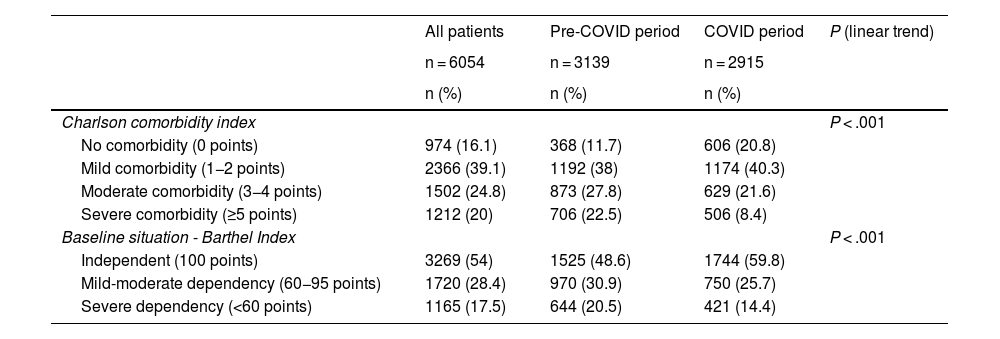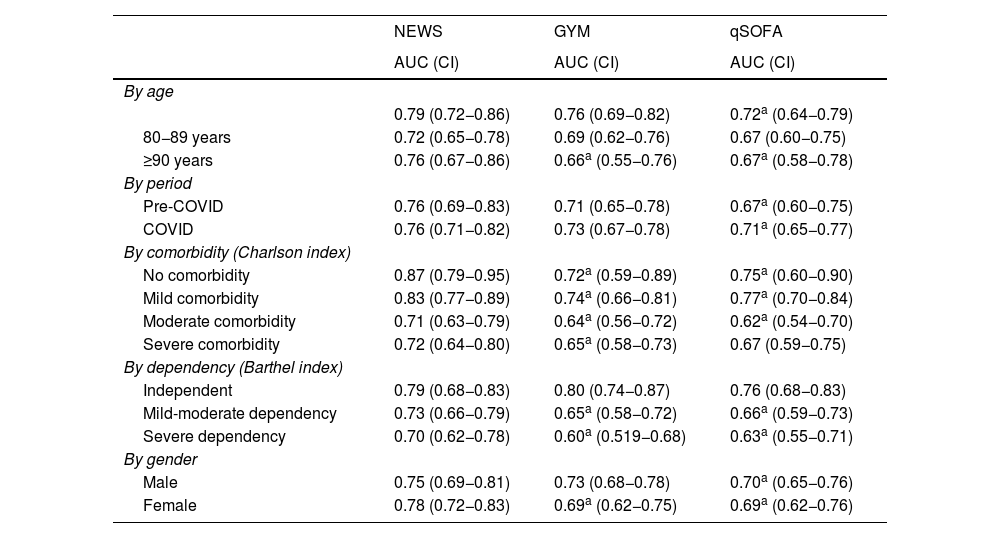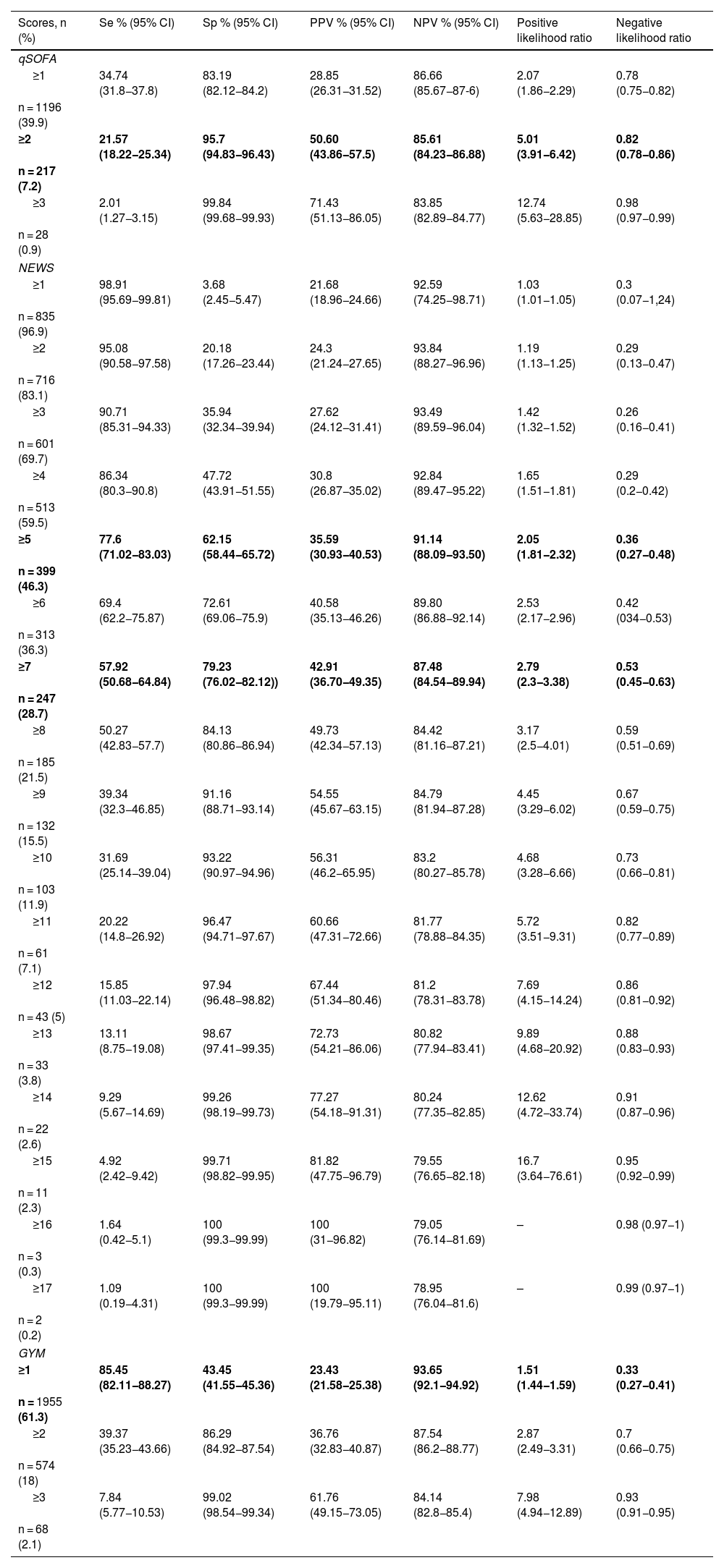To analyze the prognostic accuracy of the scores NEWS, qSOFA, GYM used in hospital emergency department (ED) in the assessment of elderly patients who consult for an infectious disease.
MethodsData from the EDEN (Emergency Department and Elderly Need) cohort were used. This retrospective cohort included all patients aged ≥65 years seen in 52 Spanish EDs during two weeks (from 1-4-2019 to 7-4-2019 and 30/3/2020 to 5/4/2020) with an infectious disease diagnosis in the emergency department. Demographic variables, demographic variables, comorbidities, Charlson and Barthel index and needed scores parameters were recorded. The predictive capacity for 30-day mortality of each scale was estimated by calculating the area under the receiver operating characteristic (ROC) curve, and sensitivity and specificity were calculated for different cut-off points. The primary outcome variable was 30-day mortality.
Results6054 patients were analyzed. Median age was 80 years (IQR 73–87) and 45.3% women. 993 (16,4%) patients died. NEWS score had better AUC than qSOFA (0.765, 95CI: 0.725–0.806, versus 0.700, 95%CI: 0.653–0.746; P < .001) and GYM (0.716, 95%CI: 0.675–0.758; P = .024), and there was no difference between qSOFA and GYM (P = .345). The highest sensitivity scores for 30-day mortality were GYM ≥ 1 point (85.4%) while the qSOFA score ≥2 points showed high specificity. In the case of the NEWS scale, the cut-off point ≥4 showed high sensitivity, while the cut-off point NEWS ≥ 8 showed high specificity.
ConclusionNEWS score showed the highest predictive capacity for 30-day mortality. GYM score ≥1 showed a great sensitivity, while qSOFA ≥2 scores provide the highest specificity but lower sensitivity.
Analizar la capacidad predictiva de mortalidad de las principales escalas pronósticas (NEWS, qSOFA, GYM) empleadas en los servicios de urgencias hospitalarios (SUH) en pacientes ancianos que acuden por procesos infecciosos.
MétodoSe incluyeron todos los pacientes de ≥65 años que acudieron a 52 SUH españoles por un proceso infeccioso, entre el 1/4/2019 y 7/4/2019 (cohorte EDEN-Emergency Department and Elder Needs-) y entre el 30/3/2020 y 5/4/2020 (cohorte EDEN-COVID). Se consignaron variables demográficas, comorbilidad, situación funcional y datos clínicos relacionados con las escalas. Se estimó la capacidad predictiva para mortalidad a 30 días de cada escala calculando el área bajo la curva(ABC) de la característica operativa del receptor(COR), y se calcularon sensibilidad y especificidad para diferentes puntos de corte.
ResultadosSe analizaron 6054 pacientes (edad mediana:80 años; 45,3% mujeres). Fallecieron 993 pacientes(16,4%). La escala NEWS tuvo mejor ABC de las curvas COR que qSOFA (0,765, I95:0,725–0,806, versus 0,700, IC95%: 0,653–0,746; P < ,001) y que GYM (0,716, IC95%: 0,675–0,758; P = ,024), y no hubo diferencia entre qSOFA y GYM (P = ,345). En la escala GYM el punto de corte GYM ≥ 1 destacó como el más sensible, mientras que en la escala qSOFA el punto de corte ≥2 presentó una alta especificidad. La escala NEWS ≥ 4 presentó una alta sensibilidad, mientras que NEWS ≥ 8 presentó alta especificidad.
ConclusiónLa escala NEWS mostró la mayor capacidad predictiva de mortalidad a 30 días. La escala GYM con punto de corte en 1 punto o más presentó una gran sensibilidad. La escala qSOFA se caracterizó por una mayor especificidad, pero una menor sensibilidad.
Article
Socio de la Sociedad Española de Enfermedades Infecciosas y Microbiología Clínica

Para acceder a la revista
Es necesario que lo haga desde la zona privada de la web de la SEIMC, clique aquí
Para realizar los cursos formativos
La actividad estará abierta para socios de la SEIMC. IMPORTANTE, recuerde que requiere registro previo gratuito. Empezar aquí












